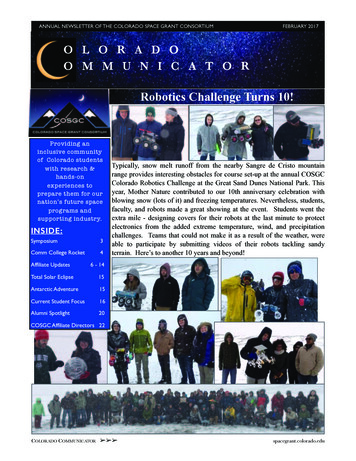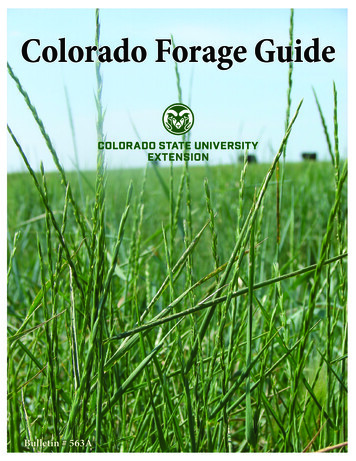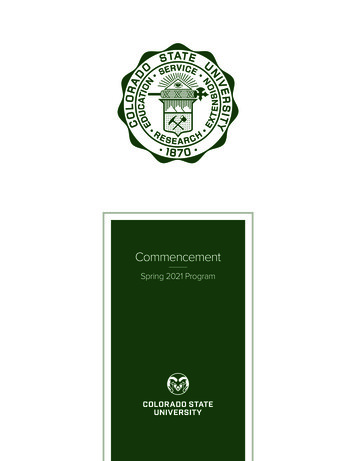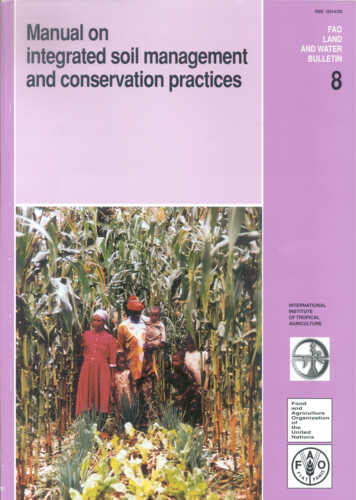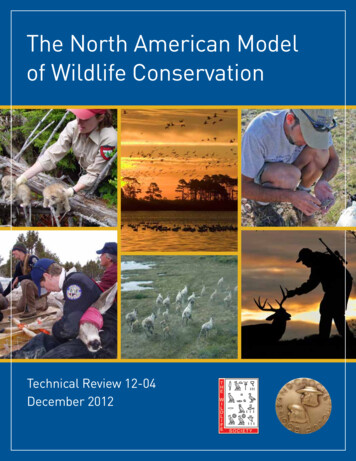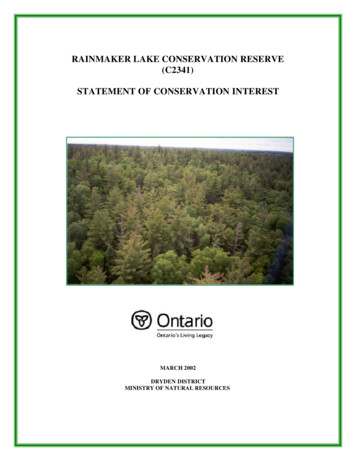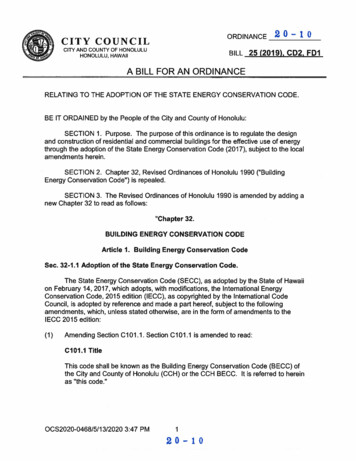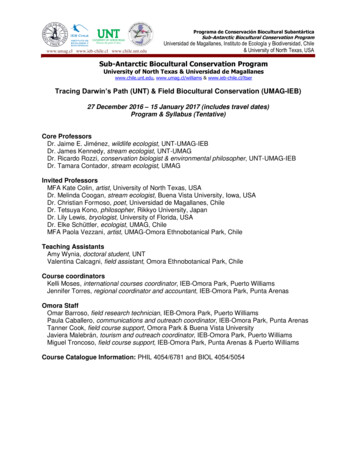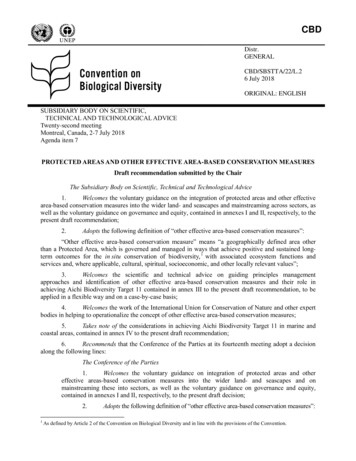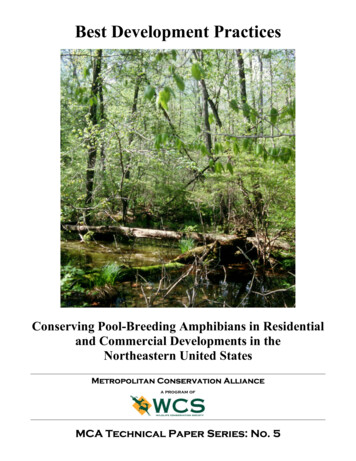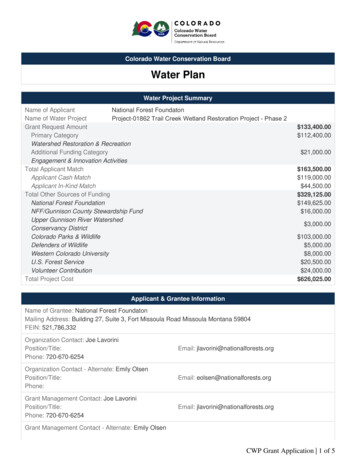
Transcription
Colorado Water Conservation BoardWater PlanWater Project SummaryName of ApplicantNational Forest FoundatonName of Water ProjectProject-01862 Trail Creek Wetland Restoration Project - Phase 2Grant Request AmountPrimary CategoryWatershed Restoration & RecreationAdditional Funding CategoryEngagement & Innovation ActivitiesTotal Applicant MatchApplicant Cash MatchApplicant In-Kind MatchTotal Other Sources of FundingNational Forest FoundationNFF/Gunnison County Stewardship FundUpper Gunnison River WatershedConservancy DistrictColorado Parks & WildlifeDefenders of WildlifeWestern Colorado UniversityU.S. Forest ServiceVolunteer ContributionTotal Project Cost 133,400.00 112,400.00 21,000.00 163,500.00 119,000.00 44,500.00 329,125.00 149,625.00 16,000.00 3,000.00 103,000.00 5,000.00 8,000.00 20,500.00 24,000.00 626,025.00Applicant & Grantee InformationName of Grantee: National Forest FoundatonMailing Address: Building 27, Suite 3, Fort Missoula Road Missoula Montana 59804FEIN: 521,786,332Organization Contact: Joe LavoriniPosition/Title:Phone: 720-670-6254Email: jlavorini@nationalforests.orgOrganization Contact - Alternate: Emily OlsenPosition/Title:Phone:Email: eolsen@nationalforests.orgGrant Management Contact: Joe LavoriniPosition/Title:Phone: 720-670-6254Email: jlavorini@nationalforests.orgGrant Management Contact - Alternate: Emily OlsenCWP Grant Application 1 of 5
Position/Title:Phone:Email: eolsen@nationalforests.orgDescription of Grantee/ApplicantNo description providedType of Eligible EntityPublic (Government)Public (District)Public (Municipality)Ditch CompanyPrivate IncorporatedPrivate Individual, Partnership, or Sole ProprietorNon-governmental OrganizationCovered EntityOtherCategory of Water ProjectAgricultural ProjectsDeveloping communications materials that specifically work with and educate the agricultural community onheadwater restoration, identifying the state of the science of this type of work to assist agricultural usersamong others.Conservation & Land Use PlanningActivities and projects that implement long-term strategies for conservation, land use, and drought planning.Engagement & Innovation ActivitiesActivities and projects that support water education, outreach, and innovation efforts. Please fill out theSupplemental Application on the website.Watershed Restoration & RecreationProjects that promote watershed health, environmental health, and recreation.Water Storage & SupplyProjects that facilitate the development of additional storage, artificial aquifer recharge, and dredgingexisting reservoirs to restore the reservoirs' full decreed capacity and Multi-beneficial projects and thoseprojects identified in basin implementation plans to address the water supply and demand gap.Location of Water ProjectLatitudeLongitudeLat Long FlagWater m location: Coordinates based on general location on streamTrail Creek, a headwaters stream of the Taylor Reservoir, Taylor River, and the GunnisonRiver.GunnisonGunnison62-Upper Gunnison RiverWater Project OverviewMajor Water Use TypeEnvironmentalCWP Grant Application 2 of 5
SubcategoryPlanning (e.g. watershed)Scheduled Start Date - Design3/1/2022Scheduled Start Date - Construction6/15/2022DescriptionThe Taylor Park Wetland Restoration Project, Phase 2 (hereinafter “Project”) is an ongoing collaborative effortwith broad community support to restore stream, riparian, and wetland habitat in the headwaters of the GunnisonRiver, on the Grand Mesa Uncompahgre and Gunnison (GMUG) National Forest.The project is part of a long-term, multi-phase effort to increase the health and quality of our water resourcesabove Taylor Reservoir. The project will work to restore riverscape health using low-tech process-basedrestoration (LTPBR) principles and treatments. LTBR treatments are simple, low unit-cost, structural additions toriverscapes to mimic natural processes to reverse legacy stressors and recover the ecological functions ofriparian and wetland ecosystems. The project’s long term plan addresses ten years worth of projects to achieveour watershed health goals (see 10-year plan attachment).In Phase 1 of the project partners built over 60 LTPBR structures along 0.3 miles of stream corridor on TrailCreek, improving conditions over an estimated 10-12 riverscape acres. Our goal for Phase 2 of the project is to1) reconnect and restore 115 acres of riparian and wetland habitat on 2.7 miles of stream corridor 2) regain thewildlife habitat and human benefits of these ecosystems.We are now pursuing funding for Phase 2 of the project to complete work in the Trail Creek drainage and collectdata to support three to five years of shelf ready sub-projects. The project budget for this grant will specificallysupport contracted services with restoration practitioners for restoration treatment implementation; projectmonitoring, studies, and reporting; volunteer coordination and community engagement; and project management.Measurable Results14,256115120New Storage Created (acre-feet)New Annual Water Supplies Developed or Conserved (acre-feet), Consumptive or NonconsumptiveExisting Storage Preserved or Enhanced (acre-feet)New Storage Created (acre-feet)Length of Stream Restored or Protected (linear feet)Efficiency Savings (dollars/year)Efficiency Savings (acre-feet/year)Area of Restored or Preserved Habitat (acres)Quantity of Water Shared through Alternative Transfer Mechanisms or water sharing agreement(acre-feet)Number of Coloradans Impacted by Incorporating Water-Saving Actions into Land Use PlanningNumber of Coloradans Impacted by Engagement ActivityWater Project JustificationPrior to human disturbance, Trail Creek was a broad valley-wide wetland complex, naturally maintained bybeavers. The North American Beaver is an aquatic ecosystem engineer and keystone species that was onceubiquitous in the riverscapes of Taylor Park and other headwaters riverscapes. But after the near-extirpation ofthe species during the 19th century fur trade—and then following almost two centuries of subsequent riparianland use and suppression of beaver populations—most of the natural stream-wetland corridors in these areashave become incised, simplified, and dried up. While sporadic beaver colonies occasionally reside along TrailCreek and other tributaries, approximately 90% of wetlands have become degraded in their absence.Degradation of this sort is responsible for a severe loss of wetland, poor riverscape health, diminished watershedresilience, and a concomitant loss of the important habitat, hydrological benefits, and ecosystem services thatthese systems would normally provide when healthy.The strategies employed by the project fit soundly within the Colorado Water Plan because the project’s goal isCWP Grant Application 3 of 5
the restoration of critical wetland and riparian habitats. This project meets numerous goals articulated inColorado’s Water Plan (please see the attachment for the specific goals and how this project relates).Phase 2 of this project will restore natural stream-wetland conditions to the valley bottom of the Trail Creekdrainage over two years. LTPBR treatments restore a stream’s structural complexity by mimicking the naturalprocesses of beaver dams (beaver dam analogs), sod root mass (sod speed bumps), and wood accumulation(woody material structures). In Phase 1 of the Trail Creek project, restoration practitioners, contractors, andvolunteers worked together to build 32 beaver dam analogs (BDAs), 12 sod speed bump structures, and 18woody material structures (mostly PALS – post-assisted log structures) along approximately 0.3-miles ofriverscape corridor, improving an estimated 10-12 acres of riverscape. Phase 2 will extend treatments up- anddownstream with the aim of restoring the full 3.0 miles (127 acres) over time.Riparian and wetland habitats that make up riverscapes are critically important to wildlife and supportgroundwater supplies. The Gunnison Basin Implementation Plan (GBIP) primary goal is to “Protect existing wateruses in the Gunnison Basin.” A complementary goal #5 is to “protect environmental and recreational water uses."This project meets both the primary and complementary goal by protecting and enhancing existing wetland areasand restoring historic wetland areas to buffer against climate change and to attenuate the flow of water acrossthe landscape for slow release during the dryer months of the year.This project also meets GBIP goal # 6 “Maintain or, where necessary, improve water quality throughout theGunnison Basin.” This project involves building LTPBR structures in incised headwater drainages. Theserestoration treatments influence hydrology and geomorphic processes, elevate water tables, increasechannel-floodplain connectivity, promote riparian area recovery, reduce peak flows, and increase sedimentretention. By restoring these habitats and reversing the cycle of degradation we will be able to prevent additionallowering of the groundwater table.This project also addresses GBIP complementary goal # 9, “create and maintain active, relevant andcomprehensive public education, outreach and stewardship processes involving water resources ” This projectis a partnership effort among federal and state land management agencies, the local university, non-profits, andcommunity members in the Gunnison Valley. The project also includes opportunities for volunteers locally andfrom across the state to come and participate in implementation of LTPBR treatments. In 2021 Phase 1 wassupported by approximately 430 volunteer hours by various partners and community members. High CountyConservation Advocates will lead volunteer engagement efforts.Finally, this project will meet the objectives of the Upper Gunnison River Water Conservancy District’s planningprocess which has an overarching goal to “protect existing uses while improving watershed health.” For all of thereasons articulated above, this project supports the goals of Colorado’s Water Plan and the Gunnison BasinImplementation Plan.Related StudiesIn preparation for the Grand Mesa, Uncompahgre, and Gunnison (GMUG) National Forest - Forest Plan Revisionprocess, the USFS completed an assessment of overall watershed health for GMUG forest lands. Thisassessment found that of the 235 watersheds on the GMUG, 76 watersheds (approximately one- third ofwatersheds) are functioning at risk (“Class 2” watersheds). The watershed ratings show that many of ourwatersheds are experiencing degradation of their physical and biological processes. Specific findings included:77% of GMUG watersheds are either in fair or poor condition with regards to large woody debris availability foraquatic habitat; 55% of GMUG watersheds are either in fair or poor condition with regards to channel shape andfunction; 149 watersheds (64%) are rated as “poor” and 22 (9%) as fair for native species. The project iscomplementary to the award winning Gunnison Basin Wet Meadows Project which also seeks to rehabilitate andsustain historically wet areas.Taxpayer Bill of RightsWe are not aware of any TABOR issues that affect our application.CWP Grant Application 4 of 5
Budget and ScheduleThis Statement of Work shall be accompanied by a combined Budget and Schedule that reflects the Tasksidentified in the Statement of Work and shall be submitted to CWCB in excel format.Reporting RequirementsProgress Reports: The applicant shall provide the CWCB a progress report every 6 months, beginning from thedate of issuance of a purchase order, or the execution of a contract. The progress report shall describe the statusof the tasks identified in the statement of work, including a description of any major issues that have occurredand any corrective action taken to address these issues.Final Report: At completion of the project, the applicant shall provide the CWCB a Final Report on theapplicant's letterhead that: (1) Summarizes the project and how the project was completed. (2) Describes anyobstacles encountered, and how these obstacles were overcome. (3) Confirms that all matching commitmentshave been fulfilled. (4) Includes photographs, summaries of meetings and engineering reports/designs. TheCWCB will pay out the last 10% of the budget when the Final Report is completed to the satisfaction of CWCBstaff. Once the Final Report has been accepted, and final payment has been issued, the purchase order or grantwill be closed without any further payment.PaymentPayment will be made based on actual expenditures and must include invoices for all work completed. Therequest for payment must include a description of the work accomplished by task, an estimate of the percentcompletion for individual tasks and the entire Project in relation to the percentage of budget spent, identificationof any major issues, and proposed or implemented corrective actions. Costs incurred prior to the effective date ofthis contract are not reimbursable. The last 10% of the entire grant will be paid out when the final deliverable hasbeen received. All products, data and information developed as a result of this contract must be provided to aspart of the project documentation.Performance MeasuresPerformance measures for this contract shall include the following: (a) Performance standards and evaluation:Grantee will produce detailed deliverables for each task as specified. Grantee shall maintain receipts for allproject expenses and documentation of the minimum in-kind contributions (if applicable) per the budget in theBudget & Schedule Exhibit B. Per Water Plan Grant Guidelines, the CWCB will pay out the last 10% of thebudget when the Final Report is completed to the satisfaction of CWCB staff. Once the Final Report has beenaccepted, and final payment has been issued, the purchase order or grant will be closed without any furtherpayment. (b) Accountability: Per Water Plan Grant Guidelines full documentation of project progress must besubmitted with each invoice for reimbursement. Grantee must confirm that all grant conditions have beencomplied with on each invoice. In addition, per Water Plan Grant Guidelines, Progress Reports must besubmitted at least once every 6 months. A Final Report must be submitted and approved before final projectpayment. (c) Monitoring Requirements: Grantee is responsible for ongoing monitoring of project progress perExhibit A. Progress shall be detailed in each invoice and in each Progress Report, as detailed above. Additionalinspections or field consultations will be arranged as may be necessary. (d) Noncompliance Resolution: Paymentwill be withheld if grantee is not current on all grant conditions. Flagrant disregard for grant conditions will resultin a stop work order and cancellation of the Grant Agreement.CWP Grant Application 5 of 5
Introduction & PurposeColorado’s Water Plan calls for an outreach, education, public engagement, and innovation grant fund inChapter 9.5.The overall goal of the Engagement & Innovation Grant Fund is to enhance Colorado’s water communication,outreach, education, and public engagement efforts; advance Colorado’s water supply planning process; andsupport a statewide water innovation ecosystem.The grant fund aims to engage the public to promote well-informed community discourse regarding balancedwater solutions statewide. The grant fund aims to support water innovation in Colorado. The grant fundprioritizes measuring and evaluating the success of programs, projects, and initiatives. The grant fundprioritizes efforts designed using research, data, and best practices. The grant fund prioritizes a commitmentto collaboration and community engagement. The grant fund will support local and statewide efforts.The grant fund is divided into two tracks: engagement and innovation. The Engagement Track supportseducation, outreach, communication, and public participation efforts related to water. The Innovation Tracksupports efforts that advance the water innovation ecosystem in Colorado.Application Questions*The grant fund request is referred to as “project” in this application.Overview (answer for both tracks)In a few sentences, what is the overall goal of this project? How does it achieve the stated purpose of thisgrant fund (above)?While this project’s primary objective falls into the Environmental and Recreation project type, Task 3focuses entirely on outreach, education, and public engagement. Our project presents an opportunity toeducate and engage the public on topics listed in chapter 9.5 of the Colorado Water Plan. The geography andhistory of Taylor Park allow outreach, education, public engagement, and innovation to occur before, during,and after project implementation.Who is/are the target audience(s)? How will you reach them? How will you involve the community?Our engaged audiences during Phase 1 of the project were students from Western Colorado University,members of the Gunnison Valley Beaver Believers, local land managers, and community members. DuringPhase 1 of the project, three community volunteer days were held during which volunteers were educatedon low-tech process-based restoration (LTPBR) treatments, and wetland habitats, and were supervisedduring the implementation of LTPBR treatments.Phase 2 of the project will target the same audiences as well as students from two local high schools. HCCAmanages a robust volunteer stewardship program, holds the ability to recruit residents from GunnisonCounty, and is currently developing a partnership with the two local high schools to engage students inenvironmental restoration projects.Community members will be invited to participate during multiple stages of the project through HCCA’svolunteer program, the Gunnison Valley Beaver Believers’ network, and advertisements in the two localnewspapers.
Describe how the project is collaborative or engages a diverse group of stakeholders. Who are the partnersin the project? Do you have other funding partners or sources?We are continuing to leverage the collaborative support of partners and community members that madePhase 1 of the project a success. Our partners include: Coal Creek Watershed Coalition, CommunityVolunteers, Gunnison County, High Country Conservation Advocates, Private Landowners, local restorationpractitioners, Sustainable Tourism & Outdoor Recreation Committee, Taylor Park Cattle Pool, TroutUnlimited, Upper Gunnison River Water Conservation District, Western Colorado University, ColoradoParks and Wildlife, Defenders of Wildlife, Bureau of Land Management, National Park Service, and the USForest Service.Describe how you plan to measure and evaluate the success and impact of the project?Engagement will by recorded and tracked by:Community Volunteer Workdays: Volunteer attendee list and log of hours Volunteer coordinator reportsEducation and outreach materials: Educational Brochure on living with beaver Website communicating information about projects, successes, LTPBR techniques, the importanceof beaver and wetlands, and non-lethal beaver management strategies for local stakeholdersAcademic and community workshop days: Workshop attendee lists Workshop coordinator timesheet and reportsWhat research, evidence, and data support your project?This project relies on community members engaging with a diverse group of multiple governmentagencies and nonprofit organizations. According to Bassler et al, 2008, outcomes of communityengagement in projects often improve citizens' knowledge and skills in problem solving. Participants learnabout the issues in-depth. Greater knowledge allows them to see multiple sides of the problem. Citizenscan practice communication and decision-making skills. Another outcome may likely result in an increasedtrust in community organizations and governance. Working together improves communication andunderstanding. Knowing what government, community citizens and leaders, and organizations can andcannot do may reduce future conflict. With this project we aim to continue to gain more local volunteersand expertise to expand our locally led climate adaptation strategies.Describe potential short- and long-term challenges with this project.The engagement aspect of this project does not face any major challenges. Initial short-term hurdles mayinclude establishing the proper protocols to make the most efficient use of the volunteers' time. Projectleaders must clearly be able to communicate the goals and objectives of the project to communitymembers.Please fill out the applicable questions for either the Engagement Track or Innovation Track, unless yourproject contains elements in both tracks. If a question does not relate to your project, just leave it blank.Please answer each question that relates to your project. Please reference the relevant documents and usechapters and page numbers (Colorado’s Water Plan, Basin Implementation Plan, PEPO Education ActionPlan, etc.).
Engagement TrackDescribe how the project achieves the education, outreach, and public engagement measurable objective setforth in Colorado’s Water Plan to “significantly improve the level of public awareness and engagementregarding water issues statewide by 2020, as determined by water awareness surveys.”Through community volunteer workdays, educational outreach materials, academic and communityworkshop days, this project will improve the level of public awareness and engagement regarding waterissues. The relevant issues include: Water-related recreation opportunity enhancement, riparian,instream, and wetland habitat improvement, promotion of riparian-dependent species and plantcommunities, wildfire mitigation, flood mitigation, and drought and climate change mitigation.Describe how the project achieves the other measurable objectives and critical goals and actions laid out inColorado’s Water Plan around the supply and demand gap; conservation; land use; agriculture; storage;watershed health, environment, and recreation; funding; and additional.The project supports the measurable objectives and critical goals and actions defined in the ColoradoWater Plan by working to enhance communication, outreach, education, and public engagement efforts.Education and outreach materials, community volunteer days, and workshops will educate a diverse groupof stakeholders on the importance of beaver as a keystone species, how to co-exist with beaver, principlesof LTPBR restoration, and the benefits of restoring historic wetlands.Our education and outreach efforts, as well as our overall ecological restoration targets, align directly withthe following goals (for more detail see Water Project Justification section): GoalsSection 6.6, pg 6-157: Promote restoration, recovery, sustainability, and resiliency ofendangered, threatened, and imperiled aquatic- and riparian dependent species and plantcommunities.Section 6.6, pg 6-157: Protect and enhance economic values to local and statewide economiesthat rely on environmental and recreational water uses, such as fishing, boating, waterfowlhunting, wildlife watching, camping, and hiking.Section 6.6, pg 6-157: Understand, protect, maintain, and improve conditions of streams, lakes,wetlands, and riparian areas to promote self-sustaining fisheries and functional riparian andwetland habitat to promote long-term resiliencySection 7.2, pg 7-11: Promote water resource resilience from natural disasters through strategicpreparedness and response.Section 10.3, pg 10-9: Use a grassroots approach to formulate projects and methods that avoidsome of the undesirable outcomes of the supply-demand gaps. The plan addresses the gap frommultiple perspectives (e.g., water storage, reuse, recycling, integrated water management,restoration, and conservation).Section 10.3, pg 10-10: Maintain Colorado’s agricultural productivity, support of ruraleconomies, and food security (through meaningful incentives and grassroots efforts).Section 10.3, pg 10-12: The protection and restoration of water quality should be a key objectivewhen planning for Colorado’s current and future consumptive, recreational, and environmentalwater needs.Section 10.3, pg 10-12: Protect and restore watersheds critical to water infrastructure,environmental or recreational areas.Section 10.3, pg 10-13: Inform Coloradans about water issues to encourage engagement andinnovation in determining Colorado’s water future.Section 10.3, pg 10-14: Respond to, monitor, and prepare for climate changeCritical Actions:Provide grants, loans, and technical support to update and improve Colorado’s aging agriculturalinfrastructure, especially where improvements provide multiple benefits.
Develop common metrics for assessing the health and resiliency of watersheds, rivers, andstreams.Promote the sustainability of endangered, threatened, and imperiled aquatic- and ripariandependent species and communities.Evaluate and incorporate appropriate adaptation for the potential effects of climate change onmunicipal, industrial, environmental, and agricultural projects and methods that address thewater supply gaps.Work on creating resilient watersheds to protect, restore, and enhance water quality in the face ofclimate change.Education and outreach materials on the importance of beaver as a keystone species, how to co-exist withbeaver, principles of LTPBR restoration, and the benefits of restoring historic wetlands will be producedfor both land managers and the public. These will include a website, and printed brochures. The websitewill communicate information about projects, successes, LTPBR techniques, the importance of beaver andwetlands, and non-lethal beaver management strategies for local stakeholders. The publication anddissemination of education materials will address objectives laid out in the Colorado Water Plan and howthis project applies to water supply and demand, water conservation, land-use planning on both public andprivate lands, agricultural benefits, water attenuation, watershed health, environmental services, andrecreation opportunities.Describe how the project achieves the education, outreach, and public engagement goals set forth in theapplicable Basin Implementation Plan(s).The Gunnison Basin Roundtable Implementation Plan has listed the primary basin goal: Protect existinguses in the Gunnison Basin. The relevant complimentary goal the roundtable listed projects create andmaintain active, relevant and comprehensive public education, outreach and stewardship processesinvolving water resources in the six sectors of the Gunnison Basin (Gunnison Basin Implementation Plan,page 10). Our project will provide educational materials on beavers and the restoration of wetlands,opportunities for community members and students to engage in the stewardship of riparian areas, andon-site educational opportunities through workshops.Describe how the project achieves the basin roundtable’s PEPO Education Action Plans.This project aligns with these sections of the Gunnison Basin Roundtable Education Action Plan for 20212022:-a.h.) Collaborating with K-12 educators, especially those involved with water related activities (e.g.,seminars, field trips, and public forums) (EAP a.h, page 2)-a.i.) Partnering with related higher education facilities such as Western Colorado University’sEnvironmental and Sustainability Program (Water emphasis section) to share pertinent water resourceinformation (EAP a.i, page 2)-b) This above-mentioned water resource information is to be customized and marketed to several distinctaudiences, including:i. basin residents, state citizens, community leaders and decision makersii. the “next generation” of Gunnison Basin water users such as K-12, high school and secondary educationstudents as well as young farmers / ranchers of the Gunnison River Basin;iii. experienced and new water users in all sectors, including municipal and industrial water providers;iv. current and potential GBRT participants and WSRF applicants, especially those that are focused CWPand GBIP activities;v. new target audiences, as appropriate, that may be identifiedc) The abovementioned water resource information will support education related to current andemerging water resource issues, for example –
a. understanding and protecting historical water usesb. water quality (e.g., selenium, nutrients, salinity, bacteria, etc.)c. hydro-climatic influences and related impacts (e.g., climate variability, warming and dust-on-snow) thatdirectly affect water resources in the Gunnison Basind. concepts and topics that relate to new and evolving regulations, permitting, river restoration,groundwater hydrology, drought planning,e. consumptive and non- consumptive needs assessmentsf. management of public lands and watershed areas that impact Gunnison Basin water resources(EAP page 3)
The following table describes the Colorado Water Plan Grant Goals that will be met through the Trail CreekWetland Restoration Project.CWP GoalPageReferenceHow Project meets GoalPromote restoration, recovery, sustainability,and resiliency of endangered, threatened, andimperiled aquatic- and riparian-dependentspecies and plant communities.Section 6.6,pg 6-157Wetland Program Priority Tier 1 species ofconcern such as the Greater SandhillCranes, Western Yellow-billed Cuckoos,Boreal Toads, and Leopard Frogs.Protect and enhance economic values to localand statewide economies that rely onenvironmental and recreational water uses,such as fishing, boating, waterfowl hunting,wildlife watching, camping, and hiking.Section 6.6,pg 6-157Hunting and fishing are commonrecreational activities in Taylor Park. TheTrail Creek drainage offers opportunitiesfor fishing, waterfowl hunting, wildlifewatching and camping.Understand, protect, maintain, and improveconditions of streams, lakes, wetlands, andriparian areas to promote self-sustainingfisheries and functional riparian and wetlandhabitat to promote long-term resiliency.Section 6.6,pg 6-157This project is designed to restore riparianand wetlands
Mailing Address: Building 27, Suite 3, Fort Missoula Road Missoula Montana 59804 FEIN: 521,786,332 Organization Contact: Joe Lavorini Position/Title: Email: jlavorini@nationalforests.org Phone: 720-670-6254 Organization Contact - Alternate: Emily Olsen Position/Title: Email: eolsen@nationalforests.org Phone:
